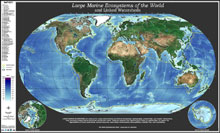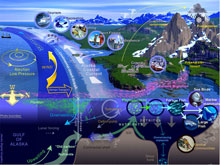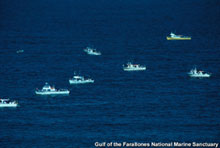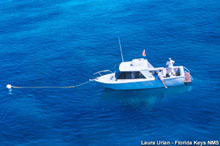Large Marine Ecosystems: A Breakthrough Concept for Ecosystem Management
- Understand Ocean Productivity
- Characteristics of LMEs
- Integrating Information on LMEs
- LMEs as a Breakthrough
- NOAA and LMEs
- Embracing LMEs Worldwide
A Need to Understand Ocean Productivity

Large marine ecosystems (LMEs) produce 95 percent of the world's fish catch, making them the focal point of global efforts for sustained and predictable productivity. Oceanographers and biologists have identified 64 LMEs worldwide. Click image for larger view.
In the mid-1980s, Dr. Kenneth Sherman of NOAA’s National Marine Fisheries Service and Dr. Lewis Alexander of the University of Rhode Island pioneered the concept of large marine ecosystems (LMEs). Sherman, Alexander, and several others recognized that large areas of the oceans function as ecosystems, and that pollution from air, land, and water and overexploitation of living resources, along with natural factors, influenced the varying productivity of these ecosystems.
Unveiling the LME concept followed years of discussion, deliberation, and development by oceanographers, marine ecologists, geographers, economists, fisheries scientists, and marine policy makers from around the world. They grappled with how best to understand the variability of large ecosystems and how to manage the oceans’ living resources for sustained productivity. In one of several volumes on LMEs Sherman and Alexander wrote:
"The LME approach brings multidisciplinary marine studies to bear on regional-scale concepts of resource sustainability by examining the causes of variability in the productivity of those regions around the margins of the world’s oceans from which 95% of the annual yields of usable fisheries biomass is harvested. Emphasis is placed on identification of the primary, secondary, and tertiary driving forces controlling the large-scale variability of biomass yields within and among LMEs."
(From Large Marine Ecosystems: Stress, Mitigation, and Sustainability, 1993)
General Characteristics of LMEs

This llustration of the Gulf of Alaska LME shows the nature and complexity of its interacting components. Ecologists and resource managers attempt to understand the various interactions and consider them in resource use and management decisions. Click image for larger view.
Large marine ecosystems are expansive ocean areas, generally greater than 200,000 km2 (77,220 mi2). They encircle nearly every continent and some large islands and island chains. Each LME has distinct bathymetry (depth), hydrography (tides, currents, and physical conditions of ocean waters), and biological productivity whose plant and animal populations are inextricably linked to one another in the food chain. Collaborating oceanographers and biologists have defined 64 LMEs worldwide.
Integrating Information on LMEs
Five information modules–biological productivity, fish and fisheries, pollution and health, socioeconomics, and governance–accompany each of the world's 64 LMEs. They help scientists and managers understand and integrate the elements of monitoring, assessing, and managing LMEs. The productivity module describes the availability of nutrients and primary productivity; the fish and fisheries module covers the status and changes in fish populations and their biomass; the pollution and health module defines the types and degree of pressure from pollutants like sediments and excessive nutrients; the socioeconomic module specifes the size and scope of activities of surrounding human populations and the various ways that humans exploit or manage the resources; and finally, the governance module analyzes the laws and regulations, as well as the various entities responsible for managing the resources and enforcing laws. These modules offer a conceptual way to integrate science and management at the ecosystem scale.
LMEs as a Breakthrough

Sport fishing is just one sector of ocean uses that marine resource scientists and managers consider in combination with many others when applying the principles of large marine ecosystems to resource management. Click image for larger view.
While ecologists have long studied and taught the concept of ecosystems, the concept of LMEs is a breakthrough in understanding how best to manage large ocean areas for sustained biological productivity. Dr. Sherman combined biogeographic, oceanographic, and ecological knowledge in innovative ways to characterize the world’s coastal ecosystems. Previous management approaches had failed to look beyond individual sectors (such as pollution discharge, mineral extraction, transportation, or fisheries harvest) and political boundaries. Those with regulatory authority over one sector made decisions on each of these uses in isolation from decisions on the others. Fish harvest decisions were made on a single-species basis, without recognizing interactions among species, such as predator-prey or competitive relationships.
Though some scientists and policy makers recognized the potential for characterizing individual ecosystems like the Gulf of Mexico and the Baltic Sea, no one had ever before applied a fully interdisciplinary approach to ocean ecosystems throughout the world. Another innovation in the LME concept is allowing resource managers to characterize and develop management approaches at an ecosystem scale, typically vast ocean areas crossing one or more national boundaries, providing a basis for cooperation among the countries that share them.
NOAA and Large Marine Ecosystems

The widespread use of mooring buoys (extreme left) is one way that LME managers give sport diving and other recreational boats a means to avoid dropping anchor and possibly damaging coral reefs or other shallow bottom habitat. Click image for larger view.
NOAA has adopted the LME as the basic unit to implement an ecosystem approach to management. NOAA anticipates this will lead to more sustainable productivity and use of living marine resources by allowing a fuller accounting of the pressures on them, and that LMEs will be the basis for marine ecosystem-based management in the U.S. in the future. U.S. coastal and ocean waters hold all or parts of eleven LMEs:
- East Bering Sea
- Gulf of Alaska
- California Current
- Gulf of Mexico
- Southeast U.S. Continental Shelf
- Northeast U.S. Continental Shelf
- Beaufort Sea
- Chukchi Sea
- West Bering Sea
- Insular Pacific-Hawaiian
- Caribbean Sea
By acknowledging that marine ecosystems occur at international scales, the LME concept has become important for NOAA's international outreach and capacity-building efforts. NOAA scientists are working in ten LMEs worldwide to introduce scientific methods for marine ecosystem observing, analysis, assessment and resource management.
Embracing LMEs Worldwide
Governments, international organizations and scientists worldwide have embraced the LME concept as demonstrated by the examples below:
- The Presidents’s 2005 U.S. Ocean Action Plan recommends LMEs as the unit for marine resource management.
- The Global Environment Facility, an independent financial organization that provides grants to developing countries for projects that benefit the global environment and promote sustainable livelihoods in local communities, has now funded LME projects in 10 LMEs and 75 countries worldwide. These projects are intended to continue over time, with national institutions replacing the support provided by donors.
- The United Nations Environment Program adopted the LME as the basic unit for its regional seas activities.
- Twelve peer-reviewed scientific volumes have been published containing descriptions and case studies of LMEs.
- Namibia, Angola and South Africa have agreed to jointly study and manage the Benguela Current LME.
Since it inception in mid-1980s, applications of LMEs have been expanding. From the original peer-reviewed volume of publications in 1989, the concept has achieved worldwide recognition. Given NOAA's stewardship mandates, this has far-reaching impacts on its science, operations, stewardshiop and management activities far into the future and around the globe.










